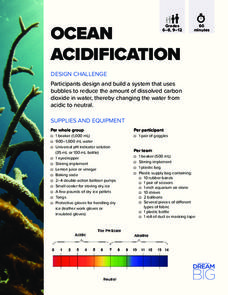Tech Museum of Innovation
Ant-Man Saves the Day
Provide Ant-Man with a flying device to aid in fighting crime. The first installment of a five-part unit has learners designing and building a flying device for Ant-Man. They write a narrative essay describing the engineering process...
Tech Museum of Innovation
Hoop Glider Design Challenge
The fourth installment of a five-part unit has young engineers designing and testing hoop gliders. They adjust the ratio of the front loop and back loop of the glider to determine the best design for the longest flight.
DiscoverE
Ocean Acidification
Combat ocean acidification with bubbles. Young engineers create a system that reduces the acidity of water. Dry ice in water helps simulate ocean acidity, and blowing bubbles into the water results in a gas exchange that neutralizes the...
DiscoverE
Squishy Circuits
Make electricity flow through Play-Doh. Individuals create animals or other creatures using Play-Doh. The engineering aspect? Eyes that light up and Play-Doh that conducts electricity.
DiscoverE
Hidden Alarm
It's time to wake up! Young engineers build an electric circuit that will activate an alarm. The use of switches in the circuit is a must—because you don't want the alarm to keep beeping forever!
National Research Center for Career and Technical Education
Lou-Vee-Air Car
Who said teaching a STEM lesson had to be challenging? Incorporate a career and technology-centered car build into your upcoming force lesson plan, and your class will be moving down the road in no time! Pupils practice...
Teach Engineering
Biodegradable Husk-Bags Design Challenge
Those corn husks can be put to good use. Future engineers design and build a new, biodegradable bag for potato chips out of corn husks. They test out their bags by shaking, dropping, and tossing them, as well as placing them in water.
DiscoverE
DiscoverE Challenge: Tallest Cup Tower
Dream big and build tall. Scholars build the tallest tower possible out of plastic or paper cups. They apply the engineering design process to refine their designs and see if they can make their towers even taller.
DiscoverE
At Home: Keep a Cube Activity
Let cooler heads prevail. Future engineers first learn about heat transfer and insulation. They then design and build a contraption that will prevent an ice cube from melting for as long as possible.
Institute of Electrical and Electronics Engineers
Radio Reception and Transmission
After reading about radio transmission, application, and the difference between AM and FM, small teams of engineers use a kit to construct an FM radio and then send and receive broadcasts. This is an ideal activity for middle school STEM...
Computer Science Field Guide
Computer Science Field Guide
Imagine computer science all summed up in one book. This resource provides 16 chapters that cover many aspects of computer science, ranging from algorithms to software engineering. The e-book contains links to applets to help explain...
Teach Engineering
Nanotechnology in Action: Organic Electronics
Even electronics are going organic. Future engineers learn about organic fibers and their uses in electronics and textiles. Specifically, they study graphene and its properties by creating graphite-based fibers in a laboratory setting...
Mascil Project
Building a Safe Staircase
Climb up the staircase of engineering knowledge. After watching a video of a carpenter measuring out steps for a set of stairs, pupils learn about the terminology and regulations involving stairs. They see how to use a rule of thumb when...
National Woman's History Museum
Hedy Lamarr, An Inventive Mind
Hedy Lamarr led a double life. Best known as an actress, Lamarr was also a brilliant inventor, responsible for the technology found in Wi-Fi, GPS, and Bluetooth. After studying primary and secondary source materials, groups conduct an...
Nemours KidsHealth
Screen Time: Grades K-2
Two lessons encourage class members to go screen-free. The first lesson challenges two teams to create a list of screen-free games. The team with the most ideas wins. Individuals then draw a picture of themselves doing one of the...
Curated OER
Earthquake Formation
Students explore earthquakes. In this natural disaster and engineer career education instructional activity, students identify features of the earth's surface that increase the likelihood of an earthquake. Students use visual aids to...
Teach Engineering
Exploring the Forces of Tension
Let the resource stretch the minds of your young scientists with a lesson about tensile strength and stiffness of materials. Groups consider how easily materials stretch and relate this property to engineering design.
Curated OER
Advanced Critical Reading: Biomimetics
Instruct your class on biomimetics while practicing reading comprehension with this worksheet. Learners read a passage that describes the efforts of scientists, starting with Leonardo da Vinci, to emulate nature to solve issues in...
Curated OER
Let's Go To The Movies
Learners explore technology used in making movies. In this movie making lesson, students investigate how technology has improved in the entertainment industry. Learners discover how simple tools are combined together to make complex...
Curated OER
Issues, Issues, Everywhere
Students identify different opinions related to an issue as well as the things that influence those opinions. They analyze how engineers use an opinion spectrum to identify the differences of opinions in a large group to investigate how...
Curated OER
TE Activity: The Great Divide
Students simulate the distribution of nonrenewable energy resources using cookies. They determine how the world's growing population effects the equitable distribution of these resources. They look at how engineers work to develop...
Curated OER
Tower Investigation and the Egg
Students build three types of towers, engineering them to hold an egg one foot high for 15 seconds. They discover that engineering designs are subject to constraints such as time, money and size specifications. In this activity students...
Curated OER
Exploring Today's Technology
Second graders explore technology. In this science lesson, 2nd graders discuss various forms of technology. Students research technology that they use everyday and write a sentence about each one of the technologies.
Teach Engineering
Quantifying Refraction
Class members discover how mathematics can quantify the behavior of light waves with the fourth installment of a seven-part series that teaches future engineers about equations related to refraction, including the equation to...























